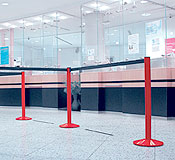Waiting lines can be a source of tension between customers and businesses, and even result in lost revenue. That’s why the role of queue management deserves much attention. “Creating a better line” is a two-pronged challenge met by using efficient queuing configurations and experiential techniques to reduce actual wait times and improve the overall waiting-in-line experience.
When it comes to queuing configurations there’s one solution everyone can recognize: The crowd control stanchion. It’s the universal symbol of the queue or waiting line; the telltale “clue to the queue.” Stanchions can play a number of important roles in creating a better line so it’s no wonder they’ve become a staple.
Stanchions make the line clear.
With stanchions in place, lines are clearly drawn. When people see a belted stanchion they immediately recognize the waiting line. Even more clearly, stanchions enable post-top signage, clearly defining the queue entrance, where customers should stop and wait, and if there’s anything that needs to happen before customers are serviced. That first stanchion says it all: “Line up here.” That’s why we usually recommend using a belted stanchion as the first post, even if using gondolas or merchandising racks to form queues.

Stanchions direct customer flow.
Stanchions are the foundational element of a successful linear queuing system, necessary to facilitate smooth customer flow. Stanchions can be configured in any number of ways and are most often joined together with retractable belts, velvet ropes, or rigid rails. Once established, stanchions deter people from going where they shouldn’t, guide the public to and through the line, and maintain a clear sense of order. Some businesses choose to combine stanchions with in-queue merchandising racks, tables, or display panels to add greater value to the waiting line.
Stanchions allow waiting lines to expand and contract.
In most business environments, customer traffic ebbs and flows throughout the day, week, or season. Stanchions allow a line to scale quickly and easily since the belts between stanchions can be removed to shorten the line during slow periods or connected to expand the line during busy periods. In retail, retractable belts are sometimes placed in between merchandising panels to easily open up the flow of traffic.
Stanchions enhance crowd safety.
An orderly line is a safer line. High traffic settings such as airports, amusement parks, movie theatres, and big-box retail stores require a well-designed queuing strategy, as much for safety as for efficiency and customer satisfaction. Stanchions play a large part in enhancing crowd control and safety by establishing clear boundaries and forming a fair and logical progression for customer flow.
All of this translates into a safer experience for all. If you’re challenged by finding the most efficient queuing configurations and practices to reduce wait times and improve the waiting line experience, we invite you to talk with the public guidance experts at Lavi. We’ll help you plan a comprehensive approach using best practices and innovative solutions to improve the quality of your line.











